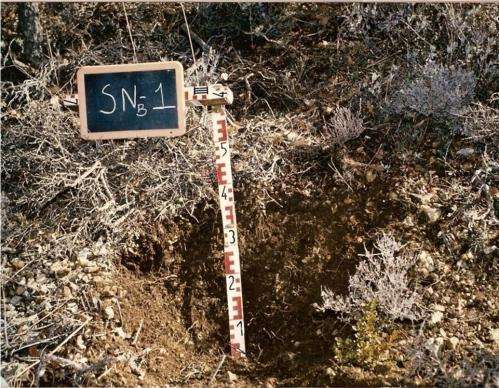Mushrooms and earthworms work as 'silviculture'

A model, developed by a research group of the School of Forestry at the Technical University of Madrid (UPM), has shown how some types of mushrooms (such as truffles, boletus or chanterelles) associated with earthworms can develop a mechanism of environmental engineering. The use of this model can increase the levels of calcium and salts among tree roots which can result in an increase in mycorrhizas and to enhance the development of forests. This phenomenon seems to happen in temperate forests at large scale and this can have a strong impact on carbon fixation and forest management.
An enigma enclosed in the rhizosphere of many forests is the accumulation of calcium and its salts (carbonates and oxalates) among tree roots. This phenomenon is surprising because of its magnitude worldwide, also due to the features of many soils where the phenomenon is produced and, finally, because it could have an impact on carbon fixation. However, the mechanisms that have explained this process had not been clarified so far.
A research group of the University of Lausanne has recently proposed an interesting model of transformation of the sunlight into rocks through a process of biomineralization. It is a rare phenomenon triggered by an interaction between oxalate and calcium carbonate of the rhizosphere which is caused by photosynthesis and the activity of the roots of an African tree (iroko) and the availability of calcium in soil. This phenomenon can be also caused by the action of termites and saprophytic mushrooms that are associated with this type of tree. Therefore, the iroko model would represent a carbon ecosystem-trap that would set this element in shaped carbonate in its rhizosphere.
Similarly, the research group of the UPM Defense and Development of the Environment has proposed another model of carbon fixation associated to calcium and diverse ectomycorrhizal mushrooms (ECMs) which is a type of mycorrhizas that are predominant in temperate forests which include truffles, boletus, chanterelles and other popular mushrooms. The Ca-ECMs model will be also associated to other organisms in the rhizosphere (earthworms) in European and North America forests. This model is similar to iroko model because both of them explain a part of the carbon fixation in forests by the relationship among calcium and its salts in soils, the sunlight (through photosynthesis) and an interaction between plant-mushrooms-animal in soil.
'Cheating symbiosis'
The mycorrhizas are mutualistic symbiosis between mushrooms and plants involved in the interchange of nutrients which are obtained by the mushrooms of soil and nutrients, and they are produced by plants through photosynthesis. However, plants minimize or avoid mycorrhization in certain environmental conditions (favorable niches for plants) or evolutionary conditions (unfavorable ecosystems for mushrooms). The Ca-ECMs model suggests that mushrooms establish a "cheating symbiosis" in which the ECMs manipulate soil properties among roots to force the mycorrhization and the "exploitation" of trees.
Diverse research studies of the mentioned group has shown how certain ECMs can develop a mechanism of environmental engineering used to increase calcium levels (and its salts) and the Ph of soil among the roots of trees, all of which boosts the development of roots and leads a nutritional stress in these trees (whose effects are known as chlorosis). This mechanism is related to the recent discovery in which ECMs search, localize, penetrate and dissolve certain selective rocks in order to extract its calcium and other nutrients such as phosphorus, an activity known as "rock-eating."
In addition, there is a synergy between these ECMs, mushrooms, and earthworms, causing a higher increase in the levels of calcium carbonate and pH among roots of trees. The final effect of this mechanism of environmental engineering is an increase in mycorrhization of trees and the development of forests.
Soils and forests hide keys that will increase the comprehension of carbon cycle and its global fixation. For years, many researchers of the department of Forestry and Silviculture of the School of Forestry have been studying these keys. Additionally, young engineers of the UPM have started professional activities related to the balance and carbon fixation.
More information: GARCÍA-MONTERO, L.G.; VALVERDE-ASENJO, I.; GRANDE-ORTÍZ, M.A.; MENTA, C.; HERNANDO, I. "Impact of earthworm casts on soil pH and calcium carbonate in black truffle burns". Agroforestry Systems 87: 815–826. 2013.
GARCÍA-MONTERO, L.G.; VALVERDE-ASENJO, I.; MORENO, D.; DÍAZ, P.; HERNANDO, I.; MENTA, C.; TARASCONI, K. "Influence of edaphic factors on edible ectomycorrhizal mushrooms: new hypotheses on soil nutrition and C sinks associated to ectomycorrhizae and soil fauna using the Tuber brûlé model". Edible Ectomycorrhizal Mushrooms. A. Zambonelli, G. Bonito (Eds.). Soil Biology 34. Springer-Verlag, Berlin. pp 83-104. 2012.
GARCÍA-MONTERO, L.G.; QUINTANA, A.; VALVERDE-ASENJO, I.; DÍAZ, P. "Calcareous amendments in truffle culture: a soil nutrition hypothesis". Soil Biology and Biochemistry 41: 1227–1232. 2009.
Provided by Universidad Politécnica de Madrid
















